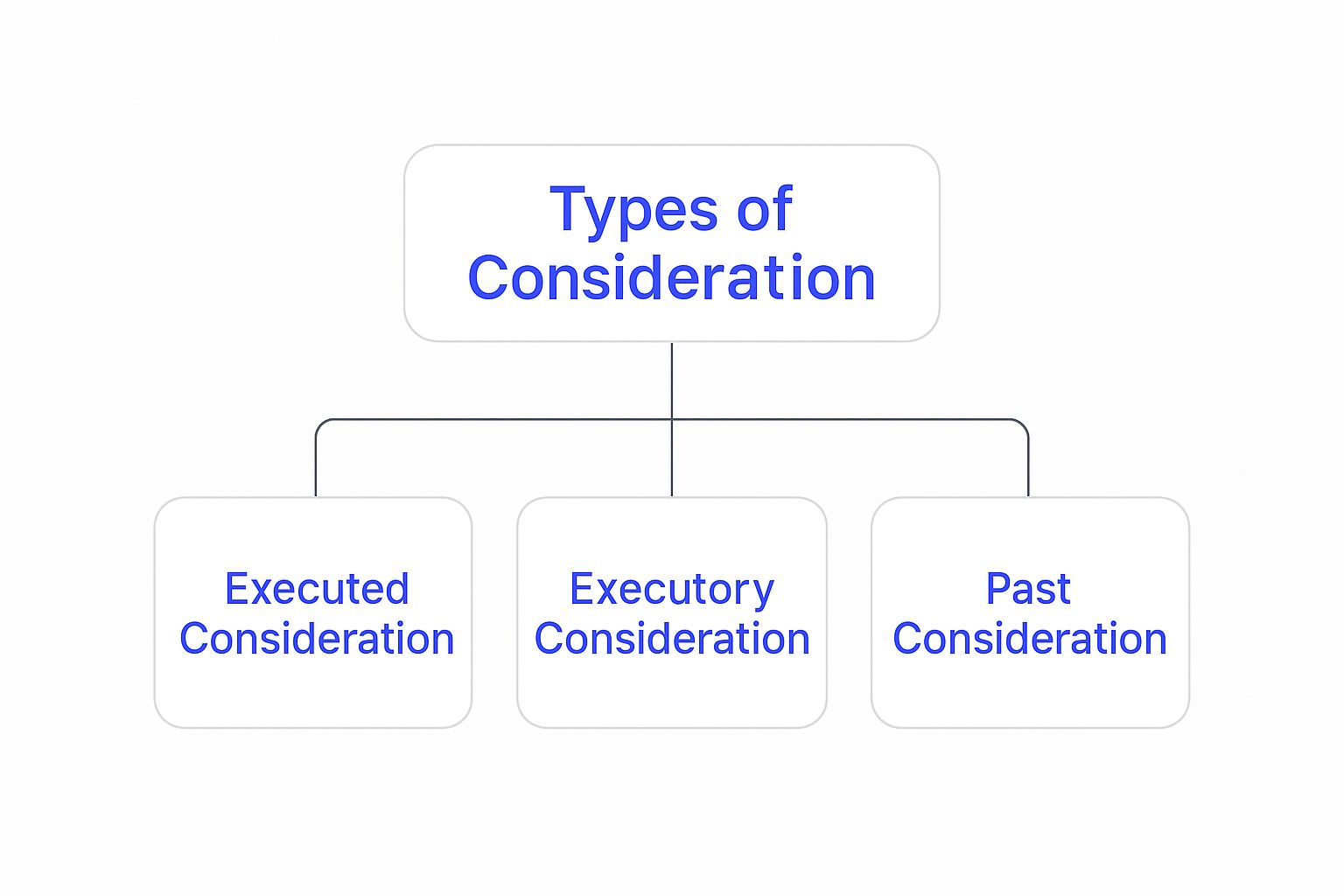
In contract law, "consideration" is a bit of a tricky concept, but it's the absolute bedrock of any legally binding agreement. At its core, it’s what each side brings to the table—the value that is promised, given, or received.
Think of it as the legal glue that holds a deal together. It’s the 'price of the promise'—what one person provides in exchange for what the other person offers.
What Is Consideration in Simple Terms?

Let's use a simple, everyday example: buying a coffee. You hand over your money, and the barista gives you a hot cup of coffee. That two-way exchange is consideration. Your money is your side of the bargain, and the coffee is theirs.
This mutual give-and-take is what separates a real, enforceable contract from a casual, one-sided promise, like offering a friend a gift. If there’s no consideration, an agreement is just an empty promise that a court probably won't bother with. It’s the critical ingredient proving both parties have skin in the game.
The concept isn’t new; it was really hammered out in the 19th century, the classical age of English contract law. A wave of court cases from that era solidified consideration as a non-negotiable part of forming a contract.
The Bargained-For Exchange
The heart of consideration is what lawyers call the bargained-for exchange. This just means that one party's promise or action has to be the reason for the other party's promise or action. It’s not about accidental benefits; it’s a deliberate trade.
To get a bit more specific, here’s a quick summary of what qualifies as legal consideration.
The Core Components of Consideration
| Component | Simple Explanation | Example |
|---|---|---|
| A Benefit to the Promisor | The person making the promise gets something of value. | A client promises to pay a freelancer. The client (promisor) gets a finished website. |
| A Detriment to the Promisee | The person receiving the promise gives something up. | The freelancer (promisee) gives up their time and expertise to build the website. |
| A Promise for a Promise | Both parties exchange mutual promises to do something. | A company promises to hire someone, and the candidate promises to work for them. |
This exchange is what turns a casual statement into a serious, binding commitment.
It provides solid evidence that both sides intended to create a legal relationship, giving the agreement real structure and teeth. To dive deeper into this, check out our guide that helps define contract consideration.
The Two Pillars of Valid Consideration
For a contract to be legally binding, the consideration can't just be a vague idea—it has to be valid. Think of it like this: a contract needs two strong legs to stand on in court. These legs are the bargained-for exchange and legal value. Without both, what you have is just an empty promise, not an enforceable agreement.
First up is the bargained-for exchange. This just means that one person's promise or action has to be the specific reason the other person makes their promise or takes their action. It’s a deliberate trade, not just a happy coincidence or a one-sided gift.
Let's say you promise to pay a painter $500 to paint your fence. That promise is what gets them to pick up a brush. In return, their promise to paint is what motivates you to open your wallet. It’s this mutual give-and-take that turns a simple exchange into a real bargain.
This infographic breaks down the common types of consideration you'll see in contracts.

As the diagram shows, consideration can be something that's already been done (executed), something to be done in the future (executory), or something done in the past (which usually doesn't count).
Unpacking Legal Value
Now for the second pillar: legal value, sometimes called legal sufficiency. This is where people often get tripped up. It has nothing to do with whether the deal is "fair" or if the price matches the item's market worth. Courts typically don't waste time deciding if you got a good deal or a bad one.
Instead, legal value simply means that a person does (or promises to do) something they weren't already legally required to do. It can also mean they agree not to do something they have a legal right to do.
It usually takes one of these forms:
- An act: Performing a service, like mowing a lawn.
- A promise: Committing to a future action, like agreeing to deliver goods next month.
- A forbearance: Giving up a legal right. A classic example is agreeing not to sue someone in exchange for a settlement payment. That's valid consideration.
If there's one key takeaway, it's this: the contract law definition of consideration is all about the existence of a bargain, not its fairness. As long as each side gives up something that has legal value, the court will generally see it as sufficient to form a real, binding contract.
Why Consideration Is the Heart of a Contract

Consideration isn't just a stuffy legal term; it's the very engine that makes a contract work. Think of it as the legal system's way of telling the difference between a serious, binding promise and an empty one you might make to a friend. Without it, even an agreement with all the right words is probably just a non-binding promise.
This concept acts as a gatekeeper, performing a few critical jobs that give an agreement its legal teeth. More than anything, it’s powerful proof that both sides genuinely intended to create a binding deal.
The Three Core Functions of Consideration
So what is consideration actually doing? It's simultaneously handling three essential jobs that convince a court to take an agreement seriously.
- Evidentiary Function: The exchange of value provides clear, tangible proof that a deal was actually struck, not just talked about.
- Cautionary Function: Requiring each side to give something up forces them to pause and think carefully before committing. This simple step helps prevent people from casually walking into serious legal obligations.
- Channeling Function: It creates a clear and recognizable signal that a promise is legally enforceable. This helps courts easily spot valid contracts while filtering out unenforceable social promises.
Together, these functions bring a sense of certainty and predictability to business and personal dealings. Let's say a friend casually promises to give you their old car next month. Without any exchange, it's just a promise to give a gift.
But if you agree to pay them $500 for it, that payment is the consideration. It transforms a simple conversation into a contract. The money proves the deal exists, shows you were both serious, and carves out a clear path for legal action if someone backs out.
Ultimately, the contract law definition of consideration isn't about memorizing technical rules. It’s about ensuring that when people make promises that others rely on, those promises are backed by a real commitment and can be trusted. This is the very foundation modern commerce is built on.
Seeing Consideration in Everyday Agreements
Theory is one thing, but seeing consideration in action is where it really clicks. This concept isn't just for law books and courtrooms; it's the engine running behind countless agreements you make every day. Once you learn to spot the mutual exchange in familiar situations, the whole idea becomes much clearer.
Let's start with a classic example: a small business hiring a freelance designer. The business agrees to pay $1,000 for a new logo. In exchange, the freelancer promises to deliver the finished design by a set date.
- The Business's Consideration: The $1,000 payment.
- The Freelancer's Consideration: The work and delivery of the logo.
This is a perfect "bargained-for exchange." The money is the reason for the design work, and the promise of a logo is the reason for the payment. This two-way trade of value is what turns a casual promise into a legally binding contract. More complex deals, like service agreements, just detail these exchanges with more precision. For a closer look, our guide on what is a service level agreement breaks it down further.
Beyond Simple Transactions
Consideration isn't always about trading money for a product or service. Sometimes, what you're giving up is a legal right. This is called forbearance, and it's just as valid.
Picture a minor car accident. Party A offers to pay Party B $500 to cover the damage. In return, Party B agrees not to sue Party A.
Party B's consideration here is the forbearance—giving up their right to take legal action. Party A's consideration is, of course, the $500. Both sides have given something of legal value, which locks in a binding settlement.
Whether it’s a straightforward purchase or a more nuanced agreement, understanding legal terms helps you see the underlying structure. From an employee agreeing to work in exchange for a salary to someone buying a house, the principle is the same. Each party has to put something on the table to get something back. That’s the heart of a solid contract.
Navigating Common Pitfalls and Exceptions

While the rules of consideration seem straightforward on the surface, real-world contracts are rarely so simple. A few common pitfalls and key exceptions can easily trip you up. Getting a handle on these nuances is what separates a basic understanding from a practical one.
One of the biggest mistakes people make is confusing a "fair" deal with a legally valid one. Courts don't act as deal critics. They aren't concerned with the adequacy of consideration, only its sufficiency. As long as something of legal value was exchanged—even if it seems like a terrible bargain in hindsight—the contract will generally stand.
Another classic pitfall is past consideration. It's a simple rule: something you've already done can't be used as the bargaining chip for a new promise. If your neighbor promises to give you $100 because you mowed their lawn last week out of kindness, that promise is likely unenforceable. The mowing was a past act, not something you did in exchange for the payment.
When Promises Are Enforced Without Consideration
Sometimes, a promise can be legally binding even without that classic back-and-forth exchange. The law has carved out a few exceptions to prevent unfair situations where one person relies on a promise, only to be left high and dry.
The main exception here is called Promissory Estoppel. This legal idea can make a promise stick if a few conditions are met:
- The person making the promise should have reasonably expected the other person to rely on it.
- The other person did, in fact, rely on the promise and took some kind of action.
- The only way to avoid injustice is to enforce the promise.
Think of it this way: a company offers a job to someone who then quits their current job and moves across the country. If the company suddenly pulls the offer, a court might step in and enforce the promise, even if a formal contract was never signed. This area of law has grown to handle situations with power imbalances, like the non-negotiable consumer agreements (or 'contracts of adhesion') we see all the time.
At their heart, these exceptions are all about fairness. The law knows that a rigid contract law definition of consideration could lead to some seriously unjust outcomes when one party is significantly harmed by trusting another's word.
Understanding these exceptions isn't just academic; it's a critical part of any effective contract risk management process. It helps you spot the promises that might carry more legal weight than you'd expect.
Common Questions About Consideration
Even when you’ve got the basics down, a few tricky questions always pop up when you apply the contract law definition of consideration to the real world. Let’s clear up some of the most common ones.
Can Consideration Be a Promise for Future Action?
Yes, absolutely. In fact, that’s how most contracts work. It’s what lawyers call executory consideration, where the exchange involves promises of things that will happen later.
Think about signing an apartment lease. You promise to pay rent every month, and the landlord promises to give you a place to live. Both of these are future actions, but they are valid considerations that make the contract legally binding the second you both sign.
Is a Gentleman's Agreement Legally Binding?
Usually, no. A "gentleman's agreement" relies on honor and social trust, not the cold, hard rules of contract law.
It’s typically missing two things a court needs to see: a clear bargained-for exchange (consideration) and proof that both sides actually intended to be legally on the hook. Without those, it's just a social promise, not something a judge can enforce.
The real difference-maker here is the lack of a mutual trade of legal value. While these agreements are important socially, they just don't meet the legal standard for a contract because nothing tangible or legally recognized is being exchanged.
Does a Contract Work if the Consideration Is Just One Dollar?
Believe it or not, it often can. This is a classic legal concept known as nominal consideration.
Courts aren’t in the business of deciding whether you got a "fair" deal—they don't care about the adequacy of the consideration. They only care that it legally exists (its sufficiency). So, as long as that $1 was a genuine part of the bargain and not just a sneaky way to dress up a gift as a contract, it’s usually enough to make the agreement valid and enforceable.
Navigating the nuances of contract law can be challenging. Legal Document Simplifier uses AI to instantly translate dense legal jargon into clear, actionable summaries, so you can understand your agreements without the high cost of a lawyer. Simplify your next contract at https://legaldocumentsimplifier.com.